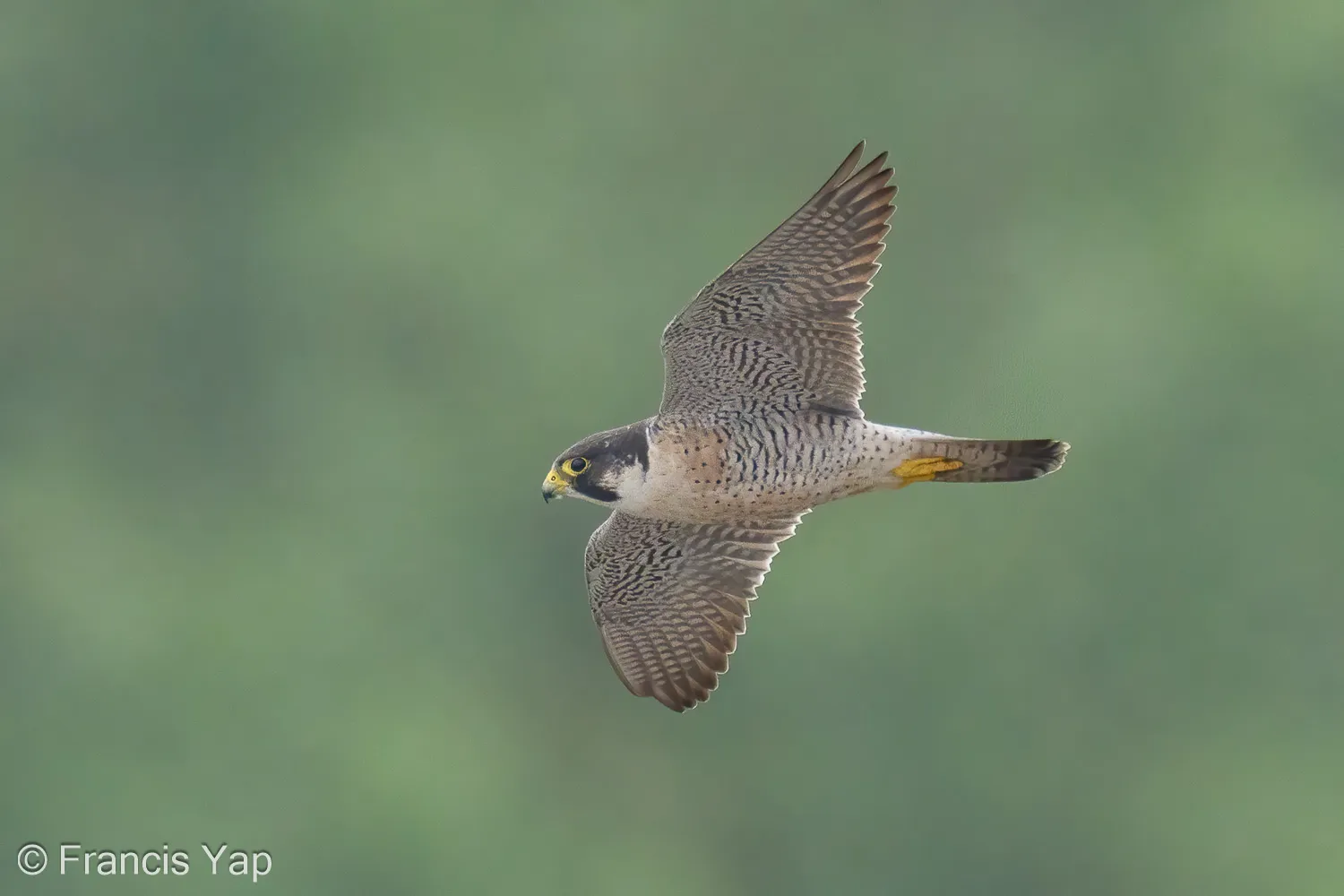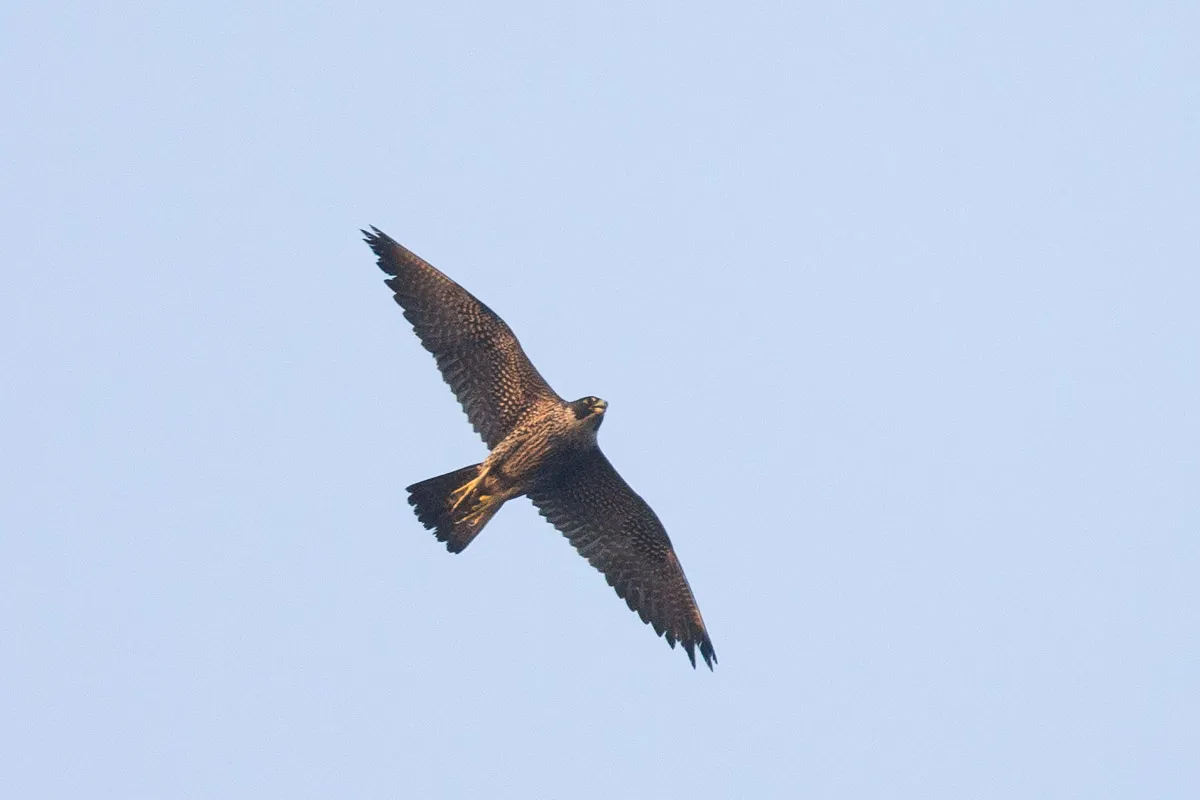Max D. Y. Khoo & Malcolm C. K. Soh
“Falcon incoming!” At the command of this exclamation, heads turn, hands shift, and cameras are raised in unison, and everyone moves with the precision of well-oiled machines. The rapid-fire click of shutters fills the air, creating a volley of machine-gun-like sounds. Whether it’s at the stairwell of an HDB block in Sengkang or, more recently, on the rooftop of an industrial carpark along the northern coast at Kranji, this is a typical scene as bird photographers gather to capture high-definition bird-in-flight photographs of Peregrine Falcons (Falco peregrinus).

In Singapore, the bulk of these Peregrine Falcons are annual winter migrants that mostly likely belong to the calidus subspecies. They breed as far north as Siberia during the boreal summer and make the long-distance journey of thousands of kilometers to spend the ‘winter’ in the tropics. When these individuals arrive in Singapore, they must refuel after the energy-intensive trip and build up reserves for the return journey at the end of the migration season. Using their incredible speed, these aerial acrobats chase down prey for their daily meals, creating a spectacle as the world’s fastest animal hunts in action. It’s no wonder photographers are always eager to capture these swift birds in motion when they’re in town.
Yet, unbeknownst to most, there is a pair of Peregrine Falcons that reside right here in town year-round, avoiding the paparazzi-like attention of photographers. This pair can be found in the Central Business District (CBD), where they have been spotted casually decapitating Rock Doves (Columba livia), much to the amusement of office workers. Unlike the winter migrants, these CBD Peregrine Falcons belong to the Southeast Asian subspecies (Falco peregrinus ernesti). They sport darker upperparts and a solid black head (vs thin black facial stripe for the migrant subspecies), and in our opinion, they look more suave than their migrant counterparts. Though this subspecies has always been recorded in various parts of Singapore, they are non-breeding visitors from neighbouring countries. They typically breed on tall limestone cliffs as tall as 3,000 meters high, so it’s no surprise that the lack of such cliffs in Singapore means they are unlikely to nest here.

In other parts of the world, Peregrine Falcons are widely known to nest on urban buildings, particularly in North America, Europe, and Australia, but also in other continents. The urban environment provides suitable nesting sites that resemble their natural cliff-side habitats. Additionally, cities often harbour abundant populations birds that Peregrine Falcons commonly prey on, such as pigeons, starlings, and gulls. These urban falcons have adapted to use the ledges and alcoves of tall buildings, which offer safety from predators and proximity to prey. However, when peregrines nest on buildings, they often do so in artificial nest boxes provided by humans.
Although we lack rocky cliffs, skyscrapers are aplenty here. Since 2018, the resident pair of Peregrine Falcons in the CBD had been observed engaging in what appeared to be incubation changeovers, suggesting that they might have nested. However, no juveniles were ever recorded. Fast forward to January 2024, the pair was observed copulating, with a nest site identified in a recess on the exterior of the OCBC Centre. With permission from OCBC, cameras were installed to confirm that the pair was frequenting the building. In April 2024, the recess was inspected, and a pair of eggs was found on the bare concrete surface. However, no adult falcons were seen incubating the eggs or visiting the nest, despite a single falcon being observed on the opposite side of the building. When the nest was checked again in May and July, the eggs were still in the same spot, unattended, indicating that the nesting attempt had failed.

The nesting observation is the first record for the resident ernesti subspecies in Singapore, albeit unfortunately unsuccessful. The multiple observations of Peregrine Falcons at the CBD and the OCBC building suggest that this subspecies can adapt very well to life in urban environments in tropical latitudes. With only a single known breeding pair at present, the Peregrine Falcon may rightly be called Singapore’s rarest breeding bird. However, the abandonment of eggs suggests that the current nesting substrate may not be ideal. Peregrine Falcons typically nest on a loose gravel substrate where they can hollow out a scrape to hold the eggs (and sometimes also in abandoned nests of other species such as ravens or raptors). It seems clear that the absence of suitable substrate may impede nesting success at this location. Moving forward, providing a nest tray with loose gravel is expected to significantly improve nesting success.
As the Peregrine Falcons of the CBD continue their quiet existence away from the usual photographic hotspots, they serve as a reminder that there’s still much to discover, even in the most familiar places. For photographers who have long trained their lenses on winter migrants, perhaps it’s time to focus a little closer to town. These urban residents may be elusive, but with a keen eye, patience, and lots of luck, one might just be the first to capture a glimpse of Singapore-born-and-bred juvenile Peregrine Falcons—a pursuit that could prove truly rewarding. As we wish for greater nesting success in the CBD and hope to see more urban buildings become suitable homes for these majestic birds, let’s keep our eyes peeled. Sometimes, the most extraordinary stories unfold in the heart of town, just waiting to be discovered.
Note: The nesting location of the Peregrine Falcons is out of bounds to members of the public. Link to the article on the nesting record of the Peregrine Falcons here.


References
Bird Society of Singapore (2024) Peregrine Falcon. https://singaporebirds.com/species/peregrine-falcon/ [Accessed 03 June 2024]
Kettel EF, Gentle LK, Yarnell RW & Quinn JL (2015). Breeding performance of an apex predator, the Peregrine Falcon, across urban and rural landscapes. Urban ecosystems, 22(1): 117-25.
Mak B, Francis RA, Chadwick MA (2021). Breeding habitat selection of urban Peregrine Falcons (Falco peregrinus) in London. Journal of Urban Ecology, 7(1): juab017.
Molard L (2009) Behaviour and ecology of resident Peninsular Malaysia Peregrine Falcons. In: Sielicki J & Mizera T (eds.) Peregrine Falcon Populations – Status and Perspectives in the 21st century. Turul/Poznan University of Life Sciences Press, Poznan, pp. 479–492.
Ong T (2019) Peregrine Falcon casually ripping other bird’s head off for lunch in CBD. Mothership https://mothership.sg/2019/05/peregrine-falcon-cbd-bird/ [Accessed 03 June 2024]
Ooi BY, Kéry M, Percival R, Lee ZH & Chiu SC (2020). A population study of tropical Peregrine Falcons in West Malaysia. Ornis Hungarica, 28(1): 11-27.
Ratcliffe DA (1993) The Peregrine Falcon. 2nd edition. T & AD Poyser, London, 454 pp. Sielicki J & Mizera T (eds.) (2009) Peregrine Falcon Populations – Status and Perspectives in the 21st century. Turul/Poznan University of Life Sciences Press, Poznan, 800 pp.
Soh MCK, Foo D, Kéry M & Khoo MDY (2024). Biodiversity Record: First recorded nesting of the Peregrine Falcon, Falco peregrinus ernesti, in Singapore. Nature in Singapore, 17: e2024077
White CM, Clum NJ, Clade TJ & Hunt WG (2020) Peregrine Falcon (Falco peregrinus), version 1.0. In: Billerman SM (ed.) Birds of the World. Cornell Lab of Ornithology, Ithaca, NY, USA. https://birdsoftheworld.org/bow/home (Accessed 3 June 2024).
